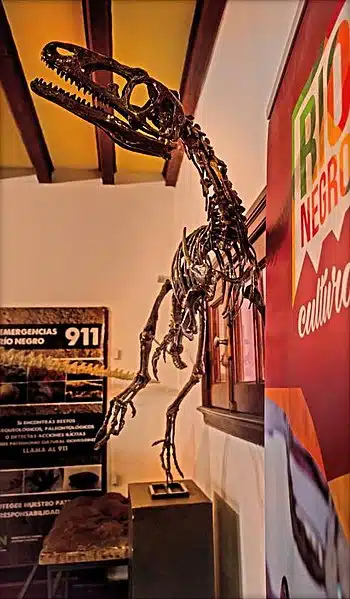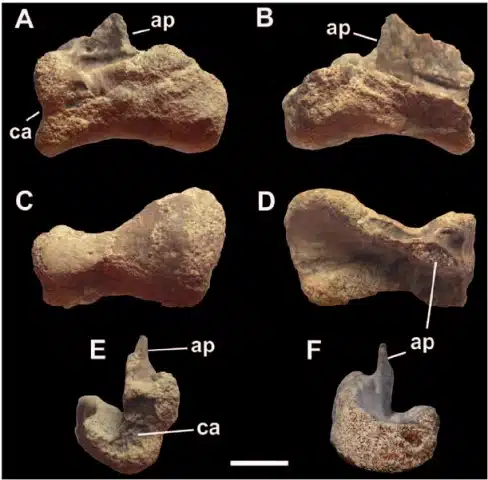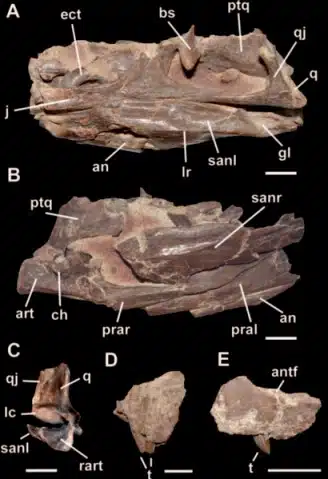As we embark on this journey through time, let’s explore the fascinating world of a remarkable creature that once roamed our planet. Bicentenaria, a name that resonates with historical significance, introduces us to a world that existed millions of years ago. This creature, a theropod dinosaur, presents an intriguing chapter in the annals of paleontology. So, let’s delve into the depths of history and uncover the secrets of Bicentenaria.
Bicentenaria Key Facts
| Keyword | Fact |
|---|---|
| Pronunciation | Bih-sen-ten-air-ee-uh |
| Meaning of name | Two hundred year anniversary |
| Group | Theropoda |
| Type Species | Bicentenaria argentina |
| Diet | Carnivore |
| When it Lived | 100.5 to 93.9 MYA |
| Period | Late Cretaceous |
| Epoch | Cenomanian |
| Length | 8.0 to 10.0 feet |
| Height | Approximately 3.0 feet |
| Weight | Approximately 70.0 pounds |
| Mobility | Moved on two legs |
| First Discovery | 1998 by Raul Spedale and friends |
| Described by | 2012 by Fernando E. Novas, Martín Ezcurra, Federico Agnolin, Diego Pol and Raúl Ortíz |
| Holotype | MPCA 865 |
| Location of first find | Ezequiel Ramos Mexía Reservoir, Candeleros Formation, Argentina |
Bicentenaria Origins, Taxonomy and Timeline
Bicentenaria, derived from ‘bicentenary’, marks the 200-year anniversary of the May Revolution in Argentina. This revolution, a pivotal moment in Argentinian history, led to the establishment of the nation’s first autonomous government. The etymology of its name, steeped in national pride, reflects a tribute to a significant historical milestone.

Diving into its classification, Bicentenaria falls under the Theropoda, specifically the Coelurosauria. Its genus, Bicentenaria, is complemented by its type species, Bicentenaria argentina. This categorization helps us understand its evolutionary lineage and how it fits into the diverse dinosaur family tree.
The timeline of this ancient creature spans the Late Cretaceous Period, precisely from the Cenomanian, dating back to around 100.5 to 93.9 million years ago. This era, a slice of Earth’s vast history, was a time of significant geological and ecological changes, setting the stage for the evolution of various dinosaur species, including our dinosaur, Bicentenaria.
Discovery & Fossil Evidence

The discovery of Bicentenaria takes us back to 1998, in the Ezequiel Ramos Mexía Reservoir, located in Villa El Chocon, Argentina. It was here that Raul Spedale and his two other friends stumbled upon this Cretaceous wonder. The fossil evidence unearthed provided a window into a world long gone but not forgotten.
Further investigations into this discovery revealed an assortment of fossils, offering glimpses into its anatomy and lifestyle. The fossils, while not complete, have been instrumental in piecing together the puzzle of Bicentenaria’s existence. They have given paleontologists insights into its physical attributes and its place in the ecological hierarchy of its time.
The holotype, MPCA 865, represents the most significant specimen of Bicentenaria. It’s through these remnants that scientists have been able to reconstruct a picture of this dinosaur’s life and times. Each fossil tells a story, contributing to our broader understanding of the Late Cretaceous Period and the creatures that inhabited it.
Bicentenaria Size and Description
The physical attributes of Bicentenaria, while partially shrouded in mystery, paint a picture of a creature adept at survival in its environment. Its body structure and physical capabilities hint at a life filled with challenges and adaptations.
This dinosaur, a member of the theropod group, likely exhibited characteristics typical of its family. With a body built for agility, it may have had a streamlined shape, supported by a strong yet flexible skeletal structure. Its limbs, possibly designed for swift movement, would have been crucial in its predatory lifestyle. The skin, while not entirely known, could have had features suited for camouflage or temperature regulation.
Size and Weight of Type Species

While specific measurements of Bicentenaria’s size and weight remain unknown, comparisons with other members of the theropod suggest a moderately-sized dinosaur. Its stature, possibly lean and agile, would have been a key factor in its predatory tactics. The varying figures for its length, height, and weight leaves room for interpretation, but it’s likely that this dinosaur was neither the largest nor the smallest of its kind.
Bicentenaria in Detail
Every dinosaur species has its distinct characteristics, and Bicentenaria is no exception. Its unique features, though partly speculative, offer insights into how it might have lived and thrived. These adaptations, from its skeletal structure to its possible hunting techniques, highlight its role in the ecosystem of its time.
The survival instincts of Bicentenaria would have been honed by the challenges of its environment. Its physical attributes, be they in hunting or evading predators, demonstrate an evolutionary journey tailored to the demands of the Late Cretaceous Period.
The study of Bicentenaria’s fossils has contributed significantly to our understanding of the coelusaurs and theropod dinosaurs in general. Each discovery adds a piece to the puzzle of dinosaur evolution, helping us paint a more complete picture of these fascinating creatures.
Interesting Points about Bicentenaria
- Its name commemorates a pivotal moment in Argentine history, linking paleontology with national heritage.
- Bicentenaria provides a glimpse into the diverse Theropod group, showcasing the variety within this dinosaur classification.
- The discovery of its fossils in Argentina contributes to the understanding of the geographical distribution of dinosaurs during the Late Cretaceous.
- Its physical attributes, while not fully known, suggest a lifestyle adept at both predation and survival.
- The study of Bicentenaria aids in understanding the broader ecosystem of its time, providing context to the Late Cretaceous Period in nowadays South America.
Contemporary Dinosaurs
In the Late Cretaceous Era, a time of ancient giants and untamed wilderness, there lived a small, bipedal predator known as Bicentenaria. As Bicentenaria sets out in search of its next meal, it treads carefully, ever aware of the potential challenges and opportunities that lie ahead.
In the dense underbrush, a rustle alerts Bicentenaria to the presence of Ilokelesia, a fellow carnivore of similar size but with a more robust build. These two predators, each adept in their own right, share a mutual respect born of necessity. While competition for prey is inevitable, their encounters are marked by a cautious understanding – a recognition of each other’s prowess and a subtle acknowledgment that today, the chase might lead elsewhere.
As Bicentenaria emerges into a clearing, its gaze shifts upwards to the towering form of Argentinosaurus. This behemoth, one of the largest creatures ever to walk the earth, moves slowly through the landscape, its massive size rendering it almost oblivious to the smaller inhabitants of its world.
Larger and arguably more powerful, Mapusaurus represents the pinnacle of predatory evolution in this era. In the presence of such a titan, Bicentenaria must tread with even greater caution. Their interactions are a complex ballet of dominance and deference, a testament to the survival instincts honed over millennia.
Bicentenaria in its Natural Habitat
This dinosaur’s habitat, characteristic of the Late Cretaceous, would have been a tapestry of diverse ecosystems. From lush forests to open plains, each environment would have presented its own set of challenges and opportunities.
As a carnivore, Bicentenaria would have been an active participant in the food chain. Its diet, likely consisting of smaller animals, would have been crucial in maintaining the ecological balance of its time. The dinosaur’s locomotion, potentially swift and agile, would have played a key role in its hunting strategies.
Beyond its individual survival, Bicentenaria’s presence would have had an impact on the ecosystem as a whole. Its interactions with other species, whether as predator or competitor, would have influenced the dynamics of its environment. The study of this dinosaur not only enlightens us about its life but also about the intricate web of relationships that defined its world.
Frequently Asked Questions
‘Bicentenaria’ commemorates the 200-year anniversary of the May Revolution in Argentina, reflecting a blend of paleontological discovery and national history.
The first fossils of Bicentenaria were unearthed in 1998 at the Ezequiel Ramos Mexía Reservoir in Villa El Chocon, Argentina.
This dinosaur lived during the Late Cretaceous Period, specifically from the Cenomanian Epoch, about 100.5 to 93.9 million years ago.
Bicentenaria is a Theropoda, belonging to the Coelurosauria.
As a carnivore, Bicentenaria likely fed on smaller animals, playing an active role in the predatory hierarchy of its time.
The study of Bicentenaria’s fossils has provided valuable insights into the theropod group and the broader ecosystem of the Late Cretaceous Period.
Sources
The information in this article is based on various sources, drawing on scientific research, fossil evidence, and expert analysis. The aim is to provide a comprehensive and accurate overview of Bicentenaria. However, please be aware that our understanding of dinosaurs and their world is constantly evolving as new discoveries are made.
Article last fact checked: Joey Arboleda, 03-09-2024
Featured Image Credit: Lucas-Attwell, CC BY-SA 4.0, via Wikimedia Commons





